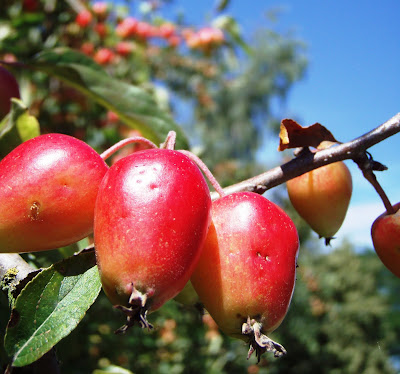While foraging about the place, I noted a lot of Crab Apple trees. I don’t know what the crop is normally like but they all seem heavily laden this season, so I think we should all try some experimentation with this very common native, but often neglected fruit. I would have thought that you could make Crab Apple Wine, at the very least. I know that it is traditional to combine these baby apples with your apple crop when making cider.
When I was a young lad, we used them as weapons. There was a huge tree that we visited in the local woods. We would stab the apples onto the end of long, whippy sticks and then sling them ballistically (my spell checker wants to turn this into sadistically, which would also be true) at each other. We would return home later tired and bruised.
Crab Apple Chutney
Ingredients
2kg mix of crab or cooking apples peeled, cored and chopped into little cubes. Shopping list
450g brown sugar
2 onions
4tsp turmeric
20 cloves
500ml cider vinegar
2tsp chilli powder
2tsp salt
10cm ginger
How to make it
Place the apples in a heavy based saucepan stir in all other ingredients, cover and bring to the boil.
Reduce heat to low and stir chutney, be sure it doesn’t stick.
Cook uncovered for about 1 hr to 90 mins, depending on size of cubes, cooking apples will fall apart, crab apples won’t. Stir regularly, it will reduce and thicken.
Leave to cool completely then pour into sterilised jars and label.
Crab Apple Jelly
1. Wash the apples, removing any bruised fruit. Put in a saucepan; fill with water to just cover the apples.
2. Bring to the boil and simmer until the fruit is soft (about 30 minutes).
3. Pour the pulp into a jelly bag or several layers of muslin and let drip overnight into a pan. Do NOT squeeze the bag or it will make the juice cloudy.
4. The next day, measure the juice, and add sugar in the ratio of 10 parts juice to 7 of sugar. Add some lemon juice, bring to the boil, stirring to dissolve the sugar.
5. Keep at a rolling boil for 40 minutes, skimming off the froth. To test the set, chill a dessertspoon in the refrigerator.
6. When the jelly is set, it will solidify on the back of the spoon. Pour into warm, sterilised preserving jars and tightly seal while still slightly warm. Store in a cool dark place.
Chilli Crab Apple Jelly (Cottage Sm Holder)
Ingredients:
•600g of crab apples washed and chopped
•35g of medium red chilli peppers, washed and chopped with seeds in
•1 litre of water
•White granulated sugar - 500g to each 500ml of juice
Method:
1. Put the chopped crab apples and chillies in a large heavy bottomed saucepan.
2. Add 1 litre of water (they should just be floating). Bring to the boil and simmer until the crab apples soften and become pulpy (lid on). About 30-45 minutes.
3. Strain through a muslin square or jelly bag overnight.
4. Add the juice to a large heavy bottomed pan and add the sugar. Bring slowly to the boil, stirring to dissolve the sugar. When the juice and sugar has come to the boil remove from the heat and skim well. Return to the heat and bring to a rolling boil until setting point is reached. Aprox 15 minutes.
5. Skim and pour into warm sterilised jars.
Pickled Crab Apples
8 quarts crab apples
6 sticks cinnamon
1/4 cup whole cloves
1 quart vinegar
2-1/2 lbs sugar
1. Select apples of uniform size, wash and remove blossom ends, but do not pare.
2. Tie spices loosely in cheesecloth bag.
3. Mix vinegar and sugar, add spices and heat to boiling. Add apples and reheat mixture slowly to avoid bursting skins. Simmer until apples are tender.
4. Pack apples in sterile jars, cover with boiling vinegar syrup and seal.
Makes 10 pints.
4 quarts crab apples, washed, cored and quartered
4 cups sugar
3 cups vodka
1. Fill 1 (4-quart) mason jar with tight-fitting lid with prepared crab apples.
2. Add the 4 cups of sugar and three cups of vodka.
3. Store the jar on its side, turning once every day for 16 days to help the sugar to dissolve.











































